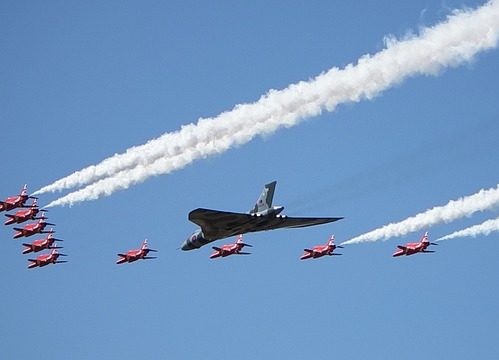

Imagine you built hundreds of wind turbines off your coast and then found out they reflect the signals used by your air defense radar?
It turns out that large rotating blades reflect radar pulses rather like planes do, and with future offshore wind turbines as tall as the Eiffel Tower and 1,000 feet wide, things are only getting worse.
RAF pilots already use the turbines to help them hide in training exercises.
The UK government has quietly spent £18m to try to figure out how to stop this and the best they have come up with is coating the blades in the type of paint used on stealth fighter jets. But the paint on F-22 jets peels off a bit too often, so they are considering something like the new ceramic paint from the F-35 program. But since that’s a top military secret, presumably it won’t be too similar. What could possibly go wrong? Since you asked, last year, after just six months on aircraft carriers, the F-35s were already looking kind of rusty.
Just drive a truckload of money to your local wind subsidy farm. Other plans include adding cameras, microphones, and radio aerials to turbines to detect hostile jets or perhaps some naughty boats and subs.
The German military have asked to be able to veto any wind development within 50 kilometers of their military radars. And given that it has 18 radars that could rule out a significant part of the German coast. The wind industry is not happy.
Imagine you bet your national economy on building thousands more of these by the end of the decade.
Thanks to Oldbrew at Tallblokes:
How wind turbines are blinding the RAF’s vital North Sea radars
By Gareth Corfield, The Telegraph
Offshore wind farms blades interfere with radar signals and there are concerns that plans for a significant expansion of turbines in the North Sea by the end of the decade will cause problems for the Royal Air Force (RAF).
Dangers in the North Sea are more than theoretical: a “ghost fleet” of Russian ships were spotted mapping communication and power cables in the area earlier this year, sparking fears that the Kremlin is preparing for a campaign of sabotage.
Some planned wind arrays are 20 miles wide.

A serving RAF officer explains: “If you have three blades on one turbine, that’s three false reflections. Imagine you then put up 10 or 20 turbines.”
Former RAF Tornado instructor Tim Davies recalls using offshore turbines to hide from ‘enemy’ fighter jets during training exercises.
“We used to fly into wind farms and rapidly change direction, knowing that their radar would struggle to see us,” he says.
Just one more reason China and Russia are encouraging the West to build fields of giant industrial wind plants in the ocean.
Photos: Top wind farm (Rhyl Flats) Andy Dingley; RAF Fighter jets photo by Steve Richardson; Gwynt y Mor wind farm, Steve Daniels.